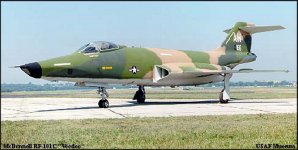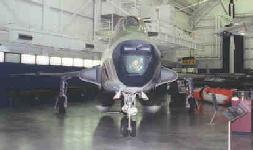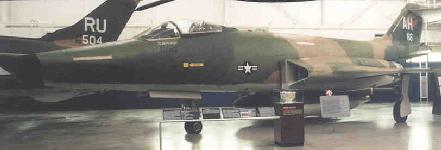


RF-101C Voodoo
The F-101 lineage included several versions: low-altitude fighter-bomber,
photo reconnaissance, two-seat interceptor and transition trainer. To accelerate
production, no prototypes were built, the first Voodoo, an F-101A, made
its initial flight on September 29, 1954. When production ended in March
1961, nearly 800 Voodoos had been built. Development of the unarmed RF-101,
the world's first supersonic photo-recon aircraft, began in 1956 while 35
RF-101As and 166 RF-101Cs were produced, many earlier single-seat Voodoos
were converted to the reconnaissance configuration.
On 27 November 1957, four "Voodoos" (RF-101 aircraft) assigned to Shaw AFB lifted off the runway from Ontario County Airport in California. The planes headed for New York and a place in history using air-to-air refueling.. The flight, known as Operation Sun Run, successfully broke the transcontinental flight record. The trip took three hours and seven minutes at a record speed of 781.74 miles per hour.
The RF-101 also served extensively in Southeast Asia during the Vietnam War. The Air Weather Service presence in South Vietnam began in December 1961 with the deployment of a single weather forecaster to Saigon to provide briefings for an RF-101 reconnaissance operation.
In the autumn of 1962, the pilots of the 363rd Tactical Reconnaissance Wing at Shaw AFB played a major part in the Cuban Missile Crisis. Utilizing their RF-101s for low altitude photo reconnaissance missions, they helped identify and track activites at Cuban missile sites, airfields and port facilities. The Voodoo helped confirm that offensive missile sites in Cuba were being dismantled. In awarding the wing the Air Force Outstanding Unit Award, President John F. Kennedy said, "You gentlemen have contributed as much to the security of the United States as any group of men in our history."
Four Voodoos were delivered to Taiwan in 1959 under Project Boom-Town.
The aircraft, flown by CNAF pilots, allegedly conducted reconnaissance missions
over international waters off the coastline of the Chinese mainland, but, in fact,
penetrated deeply into the Chinese airspace. The first Voodoo was shot down in
August 1961; in less than four years three others were downed. The US Air Force
transferred another four aircraft to cover these losses. RF-101s operated
successfully over mainland China for several years before operational attrition
ended their careers.
Specifications
|
| Span | 39 ft. 8 in.
|
| Length | 69 ft. 3 in.
|
| Height | 18 ft. 0 in.
|
| Weight | 51,000 lbs. max.
|
| Engines | Two Pratt & Whitney J57s of 15,000 lbs. thrust each with
afterburner
|
| Maximum speed | 1,000 mph.
|
| Cruising Speed | 550 mph.
|
| Range | 2,060 miles
|
| Service Ceiling | 45,800 ft.
|
| Cost | $1,276,245
|



Sources and Methods
http://www.fas.org/irp/program/collect/rf-101.htm
Created by John Pike
Maintained by Steven Aftergood
Updated Tuesday, March 09, 1999 12:17:06 PM








